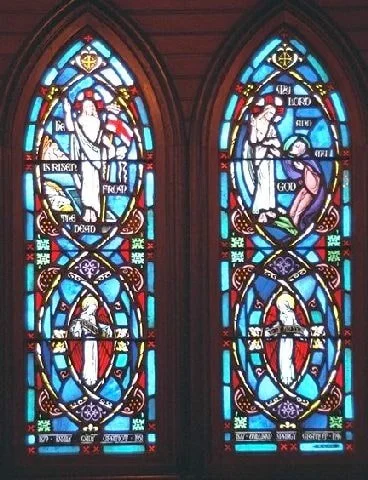A Brief History
St. Mary’s was founded by a small group of Episcopal women on Annunciation Day in 1886. It was the first church building constructed in Pacific Grove. The architect modeled St. Mary’s after a church in Bath, England. On July 10, 1887, The Rt. Reverend Bishop Kip, the first Episcopal Bishop of California, presided at the dedication of St. Mary’s.
In 1890 the congregation built a rectory and a parish hall on the grounds. For decades St. Mary’s parish hall served Pacific Grove as the largest meeting hall in town, and it hosted dramas, concerts, and meetings. Over the next 20 years, the congregation outgrew the little church and in 1911, the church was greatly enlarged by splitting it in half and adding two bays as well as the front porch.
The parish kept growing, and in 1965 St. Mary’s replaced the old rectory with a two-story Christian education building, now known as Clay Hall. Over the years, memorial stained-glass windows in a variety of styles were given to the church, replacing many of the original brown windows. In 1922, farm machinery tycoon Cyrus McCormick, who had married his wife, Harriet, at St. Mary’s, donated a pair of stained glass flower windows by Louis Comfort Tiffany as a memorial to Harriet.
In 1996, the parish installed a 20-rank Schantz pipe organ. In 1991, the parish hall was dedicated as Edwards Hall in honor of The Rev. Dr. Dwight W. Edwards, our rector from 1973 to 1998. The most recent addition to St. Mary’s is the Leslie Garden, which includes a columbarium. It was completed and consecrated in 2016, named in honor of retiring rector, The Rev. Richard Leslie.
St. Mary’s Stained Glass
Little Red Church in the Pandemic
During the COVID-19 pandemic, parishioner Karin Forno conducted a series of interviews of members of St. Mary’s. She is publishing them as a series over time on the St. Mary’s website. Read them here.
History of the Sanctuary Building
St. Mary’s Parish was founded by a small group of Episcopal women in 1886. It was built, in 1887, on land donated by the Pacific Improvement Company and was the first church building constructed in Pacific Grove. The architect, William Hamilton, of Sacramento, modeled St. Mary’s after a church in Bath, England. On July 10, 1887, The Rt. Reverend Bishop Kip, the first Episcopal Bishop of California, presided at the dedication of what came to be known as the “little red church that cares.”
The church was significantly enlarged in 1911 by splitting it in half and adding the choir and the first two bays. This enlargement was based on a plan devised by Lewis P. Hobart, the architect of Grace Cathedral in San Francisco. The porch entry was also added. The parish hall was constructed in 1893 and dedicated in 1991 to the Reverend Dwight Edwards, Rector for 25 years before his retirement in 1998. The education and office building, named after Rev. D. Albert Clay, Rector from 1926-1936, was erected in 1965 on the site of the former rectory. Both the church and Edwards Hall are constructed of No. 1 grade redwood no longer available at any price today. The church interior also includes pine, cedar, fir and walnut. The chancel rail is of oak and the bas relief reredos and the memorial altar is camphor wood. The church bell, one of the first gifts to the parish, was donated before the church itself was built.The present organ, built by Schantz Organ Company of Ohio, was installed in 1996. Internationally known organist, David Higgs, played the inaugural concert. The organ contains 20 ranks of pipes, two keyboards and a pedalboard. It has an electro pneumatic action. Some pipes are wood, others of a metal alloy of tin and lead. There are 1157 pipes on the wind chests in the loft over the console.The memorial altar is dedicated to those who have served in the armed forces. The cross was designed by E. B. Lewis and memorializes, with four gold stars, the men from St. Mary’s who died in WWI. The reredos, above the altar, was designed by Sigismund Wolf of Carmel, and carved by Taiwanese craftsmen. The Stations of the Cross were gifts from the craftsmen to St. Mary’s.The Madonna at the rear of the church was hand carved in Italy and given in 1981 in memory or Erik Olinger. The Italian marble baptismal font was one of the first gifts to the church, donated in 1887 by Mrs. A.A. Taft of New York City.











